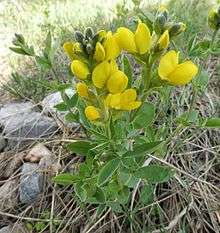Thermopsis rhombifolia
Thermopsis rhombifolia, also known as prairie thermopsis,[1] is a flowering plant in the legume family. It is native to North America, where it is found in the Great Plains, with extensions into the lower canyons of the Rocky Mountains. Its natural habitat is dry grasslands and woodlands.[2][3]
| Thermopsis rhombifolia | |
|---|---|
 | |
| Scientific classification | |
| Kingdom: | Plantae |
| Clade: | Tracheophytes |
| Clade: | Angiosperms |
| Clade: | Eudicots |
| Clade: | Rosids |
| Order: | Fabales |
| Family: | Fabaceae |
| Genus: | Thermopsis |
| Species: | T. rhombifolia |
| Binomial name | |
| Thermopsis rhombifolia | |
It is a perennial that produces yellow flowers in the spring.
Usage
The flowers were commonly used by the natives as a source of yellow dye and were boiled in a tea as a cure for stomach ailments for people and horses. The plant has toxic properties if ingested; symptoms of poisoning include vomiting, dizziness, and abdominal pain.[4]
gollark: Skynet or enchat?
gollark: If not it should.
gollark: Does it use skynet?
gollark: I should see about making a sensible event-based krist client, or at least a wrapper for the silly jua one.
gollark: Indeed.
References
- "Thermopsis rhombifolia". Natural Resources Conservation Service PLANTS Database. USDA. Retrieved 9 December 2015.
- Chen, Chia; Mendenhall, Meghan; Turner, Billie (1994). "Taxonomy of Thermopsis (Fabaceae) in North America". Annals of the Missouri Botanical Garden. 81 (4): 714–742. doi:10.2307/2399917. hdl:2152/31128. JSTOR 2399917.
- Southwest Colorado Wildflowers
- Case series of Thermopsis exposure Retrieved 25 April 2006
| Wikimedia Commons has media related to Thermopsis rhombifolia. |
This article is issued from Wikipedia. The text is licensed under Creative Commons - Attribution - Sharealike. Additional terms may apply for the media files.